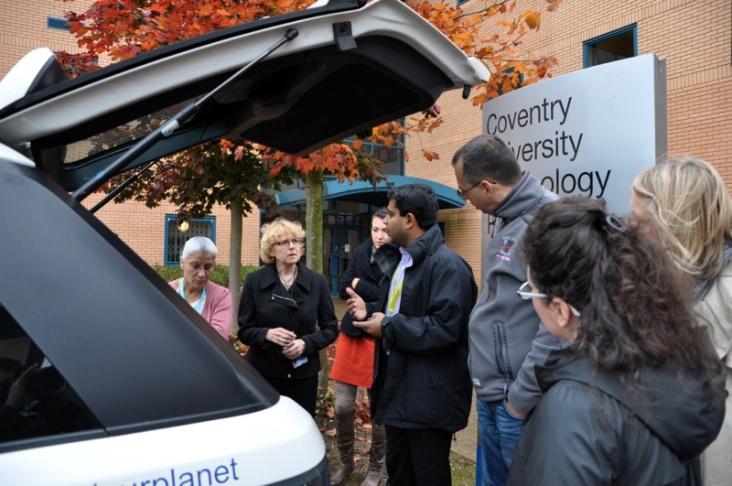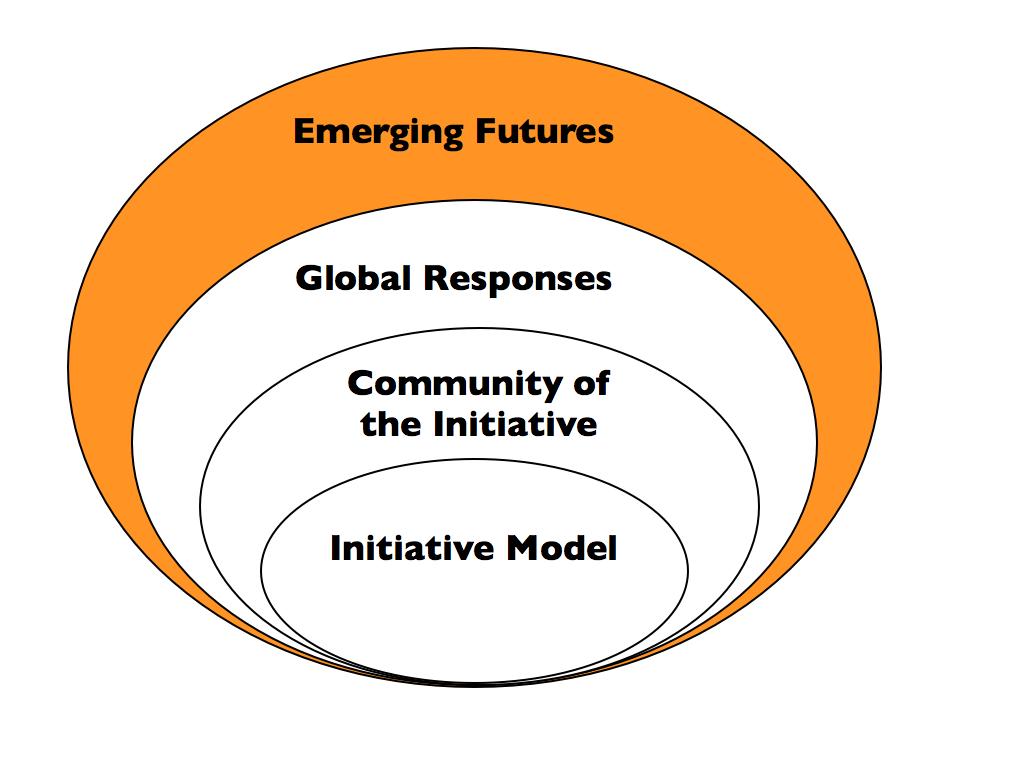
17 minute read
new tool for Living Labs
Futures in action -the ‘Futures Action Model’ a new tool for Living Labs
Gareth Priday and Jose Ramos a
Advertisement
a
Action Foresight, Melbourne (Australia)
Abstract
We present the ‘Futures Action Model’ (FAM) as a framework to support the initiation of new Living Labs but also as an innovation support tool in itself. FAM bridges the gap between emerging futures and real life action, whether articulating the core purpose of an organisation or developing a new service. We believe the FAM would be a useful addition to the existing innovation tool set for the Living Lab community and fits well with existing techniques.
Key Words
FAM, Futures, Strategy, Service, Innovation
1Introduction
Living Labs are relatively new to Australia with only one a member of ENOLL. Australia has an innovation policy of using Collaborative Research Centers (CRC) as a mechanism to bring together Industry and University researchers. Australia also has a long history of using large scale search conferences and systemic action research as ways to bring cross sector stakeholders together for join inquiry and action, following the work of Fred Emery and others (Wadsworth, 2010). In this paper we present FAM, a framework which fits well with the ethos of living labs and can be used as a framework to inform the set-up of a new Living lab (or CRC) and as a useful component of the project innovation cycle.
2Introducing the Futures Action Model
The Future Action Model (FAM) was developed to bridge the gap between emerging futures and real life action (Ramos, 2013). FAM has 4 Layers
· Emerging Futures · Global Responses · Community of the Initiative · Initiative
While the layers are presented from ‘Emerging Futures’ to ‘Initiative’, in practice when completing the framework there will be significant jumping around between the layers as people usually have some view on the required initiative already. This
is expected and doesn’t detract from the final outcome; rather it provides a way to capture current thinking and concerns, which can then be placed in a larger context. Comparing the two is part of the process for refining the development of the Initiative, in this case a living lab or a service within a living lab.
3Emerging Futures
Diagram 1: Emerging Futures
This layer explorer the emerging issues in the world around us, with an emphasis on moving beyond the headlines and exploring a variety of future alternatives. Depending on the initial idea for the living lab we might explore climate change, ewaste, precarity, social exclusion, ‘big data’ or many other topics. These emerging issues may be in the social, environmental, political, economic, or technological domains. Classic futures tools and techniques are most valuable here including, environmental scanning, scenario development and three horizons (Curry, 2008).
4 Global Responses
Diagram 2: Global Responses

The ‘Global Responses’ layer reveals different innovation opportunities. This layer explores the social responses to these emerging issues, what social practices are being trialed, new technologies developed, social innovations championed. Many of these will reveal themselves through the same tools and techniques as in the emerging futures layers. The difference between the two types is to differentiate between the responses which require people to act and constitute a type of solution rather than the issues and trends from which the actions emerge - the initial problem. For example, one team working on the futures of aviation began to explore a variety of issues impacting aviation. They decided to focus on two main issues or problems: the problem of carbon emissions, and the problem of rising fuel prices –both threats to the aviation industry. Global Responses to this varied from sector to sector and by geography, from efforts to create second generation biofuels, to efforts to establish low carbon policy among aviation peak bodies / associations. The key conception metaphor here is that we now live in what might be called a “global learning laboratory”. Whereas in the past both the problems people faced and the solutions created may have seemed disconnected, suddenly, in a matter of decades, we are interconnected by problems that look similar or have strong thematic overlaps underlying the processes of globalization; equally, empowered by new web technologies we are learning from each other across geographies like never before. A sustainability strategy in a northwestern US city now has value for others looking for policy options, and Australian applications of permaculture can be evaluated for application in Africa, or the success of a Brazilian transport solution can be considered in a different context. The notion of a global learning laboratory has strong resonance with the idea of a living lab - the living lab being a subset of the global process of innovation. This is simply to emphasize that where people act there is organization and value created between the different stakeholders which will then inform the development of the lower layers of the FAM model. There are two specific types of innovation opportunities within the framework, relocalisation and gaps. Services and products developed for a different context can often be moved and adapted to a new local context, a “re-localisation” of the innovation. This is the aim, for example, of the “smart cities” tool kit (City SDK, 2014), which can be implemented in any city. Each implementation is likely to have some adoptions, a service can be moved to Australia but it will need adapting for the Australian councils systems, laws, infra-structure differences and so on. Gaps are either gaps in the global response where there are opportunities to innovate which might have global application. Gaps may also be about specific context differences which open up opportunities for innovations. These context differences may be geographical, technical infrastructure, legal for example. Often, innovation opportunities exist where there is a gap between responders ability to network and coordinate. In another example, a team looking at animal welfare issues identified that there were a large number of animal rights organizations across Australia, however there were no connections with University campuses and clubs. They found a gap between the Australia wide networks and advocacy groups and their engagement with Uni students. The decided to address this gap by conceiving of an organization that specifically acted as a liaison between university clubs and the larger national advocacy organizations. Thus the identification of gaps can be conceived of connecting existing ‘global responses’ within a more coordinated or coherent
development process. In this case the Initiative was not to create another advocacy organization (of which there were a number) but to create a bridge between them and university student life.
5Community of the Initiative
Diagram 3: Community of the Initiative
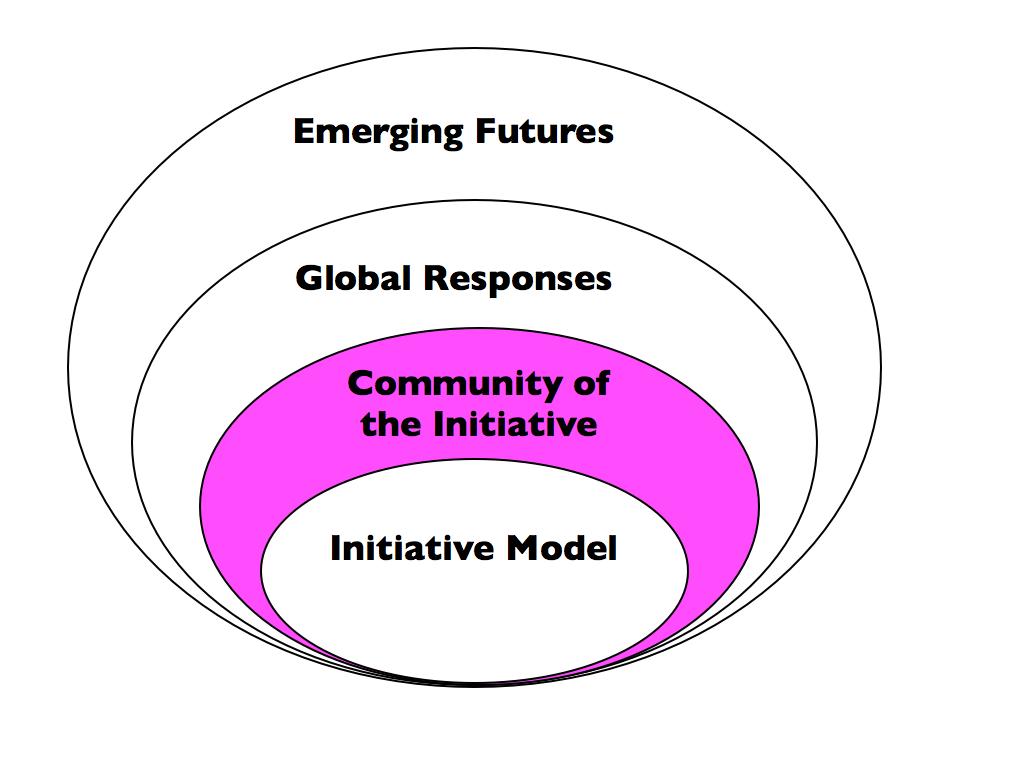
The community of the initiative is the boundary between looking at the global context and developing a proposal for a local initiative. This layer identifies the stakeholders and develops the value propositions for each of the stakeholders. The team working through the problem is likely to have a view on both the initial set of stakeholders and the value propositions. Here the value propositions take a ‘service dominant logic’ view of the value propositions where parties co-create value. Even for technological innovations people are providing their expertise in the development of a technology which supports value co-creation with a variety of eventual users. The global responses will inform the list of potential stakeholders and value propositions. There may be entities identified that could be real partners to the initiative; other may reveal additional stakeholders that should be replicated in this new initiative. Similarly by exploring the value propositions in the global response space the initiative being developed might uncover additional value propositions or solidify the uniqueness of the proposed initiative. Value will have different meaning to different stakeholders and different stakeholders will use their knowledge and expertise to support this value creation. To support the identification of the different needs of stakeholder actor analysis can be used to elaborate on the detail of each stakeholder’s contribution and needs. In an example of FAM work, a team explored solutions to the problem of E-waste in Australia. Having seen a variety of ‘global responses’ at work around the world, they began to consider who could be part of an Australian initiative. Consumers were considered primary actors because of the consumption of electronic devices. A number of Australian E-waste recycling companies were also considered important. Importantly, electronics manufacturers were considered critical, as they were already pushing for industry level standards and were keen to promote themselves as product stewards. Finally, government regulators were considered crucial in establishing ‘rules of the game’ level policy and law that could shift the
dynamics of the situation. They conceived of a value exchange system by which each of these 4 stakeholders: consumers, E-waste recyclers, e-manufacturers and government, would work together to satisfy each others need in crucial ways. The work at ‘global responses’ had helped them to identify the critical elements in a new ‘cradle to cradle’ E-waste system that could radically reduce e-waste - indeed redefine e-waste into E-resource.
6Initiative
Diagram 4: Core Model
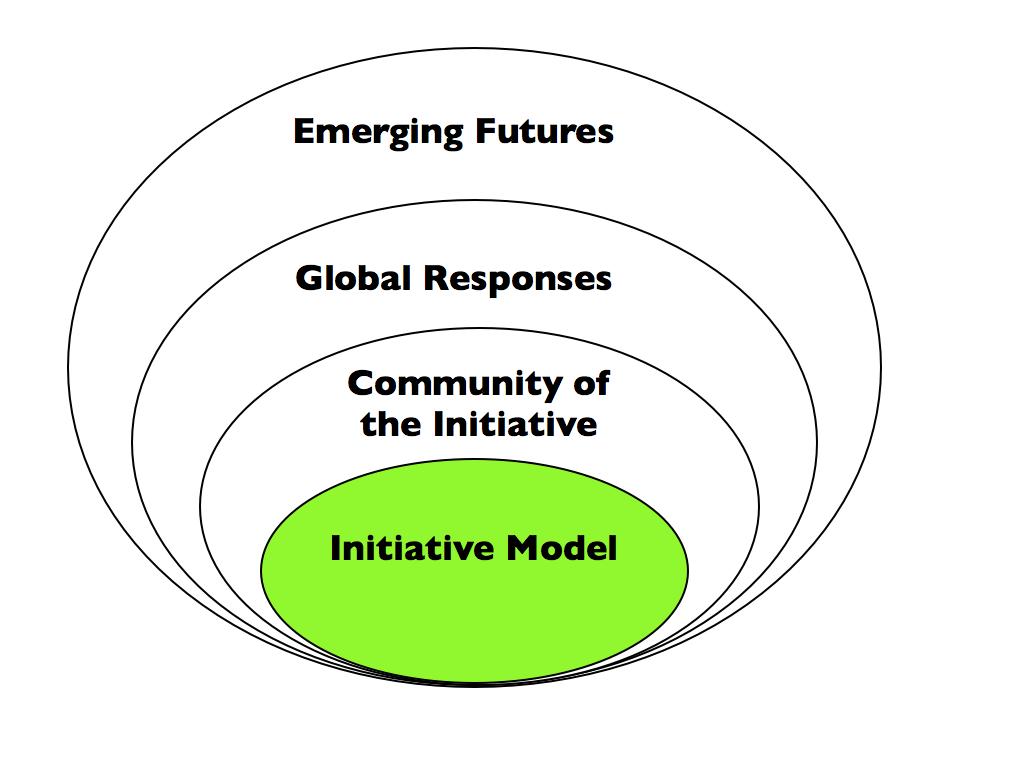
The initiative develops the model of an initiative through a conceptual scaffold: purpose, governance and resources. These three components can be seen in the metaphor of a ship.
Ø The purpose of the initiative is what it exists to do - what is the purpose of the ship and where is it intended to go? A local journey, to the edge of the Earth, or beyond? Ø The governance of the initiative is how decisions are made - who runs what on the ship, who decides where the ship will go? Captain, crew, company or a combination? Ø The resources of the initiative are the means by which those that govern enact and fulfill the purpose - energy to get from A to B, the sails, wind, labor / those who operate the sails.
One initiative concerning the issue of nutrition and healthy eating for kids, conceived of a Canteens program, whose purpose is: “to reinvest capacity and [create] healthy food choices in school students by mentoring and developing skills through a curriculum which promotes a healthy food culture through co-curricular activities and runs a canteen serviced by a farms and schools model.” The project aims to link farmers, students and educators in a virtuous cycle. The farmers are engaged in delivering local produce. Educators drive learning around healthy eating and environmental and social sustainability. In the process students are educated about healthy eating and the importance of food re-localization for both local business and global sustainability. The initiative is run by a program committee, but gets support from program partners, council and grants, as well as
volunteers from partners (local gardeners, farmers, cooks etc.) Local farms, students, schools, local businesses and community mutually benefit.
An initiative will often reflect a new value exchange system between stakeholders that may not have been connected before. The new relationships are facilitated by the initiative - as the initiative pioneers have a ‘systems’ level mental map and understanding - they can see how different organisations and people might connect and exchange value in new ways - or they have an intuition about what relationships might be generative - even though they may not know the outcome. These pioneers hold the emerging complexity of the new system and create an initiative that can facilitate a new value exchange between people and elements who were previously not partners, collaborators or exchangers - but who now find common interest and the value of collaboration or exchange.
While there are common elements across Living Labs there are many different business models, lifespans and stakeholders. This layer develops the relationships between all of those stakeholders and the resources and efforts needed to work towards a common goal. For initiatives within an existing Living lab some elements of this may be a given in the sense that aspects of governance are likely to be semi-prescribed with only some variation within an initiative. The resources are likely to be different in most cases. Similarly meeting stakeholder needs during the development cycle will be different for many projects.
7Application of FAM to Living Labs
A key success criterion for a Living Lab is that the participants all share a clear strategic intention (Garcia-Guzman et al, 2013; Veeckman, C, 2013). Living Labs, like CRCs, have in-built tensions between the different participant groups; universities will tend to focus on longer term approaches compared to business participants for example. These tensions can be more easily managed where there is a shared vision which makes the compelling case for each participant to stay in the Living Lab structure in a flexible way. The activities of a Living Lab such as openness between stakeholders, having an ecosystem approach and building a community will all be easier if there is a clear shared strategic intention. Understanding who the relevant stakeholders are to set-up a Living Lab is also important, especially as both types of organization seek to work collaboratively on an international scale (ENOLL, 2014).
Working through FAM the strategic intention of the organisation reveals itself through the interactions between the layers. Looking at the emerging issues and responses enables people to point to key areas of concern for the (emerging or established) LL community and what types of initiatives are similar to their needs. Italso helps to highlight responses that are not of interest.
As mentioned previously, when practicing FAM as a workshop method, participants will often fill in layers in any order, usually having a view of what the initiative should look like from the outset. Filling in this layer may trigger a search for similar enterprises in the global response section. When the other layers are added in the interaction refines and changes the core idea of the initiative - it has the benefit of an expanded view of stakeholders / partners, issues and models. Additional stakeholders may be brought in which will trigger further refinements.
The process is both layered and iterative as new material is added to each layer which triggers a cycle of refinement. Over time the process stabilises and stakeholders can work through the details of the initiative. Doing this work together in itself has served as a process for developing understanding and community which helps ease the natural tensions when groups with different needsare brought together.
On a theoretical note, the iterative nature of the process initially drew from Conklin {Conklin, 2006 #260}, who challenges the ‘waterfall’ model of problem solving. He argued that problem solving is often taught in universities and management school as a linear process, but that how problems were solved was different in practice.
Diagram 5: The waterfall model from Conklin (2006)
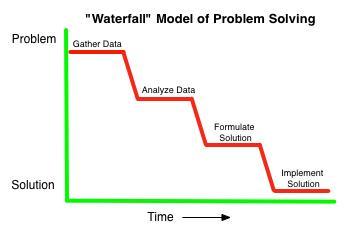
By contrast, in Conklin’s own research he found that designers did not follow a linear pattern in their problem solving approach. Rather, problem solving remained dynamic through the life of the design process. Indeed, when working collaboratively, designers would often be addressing different dimensions of the process simultaneously.
Diagram 6: The waterfall model challenged from Conklin (2006)
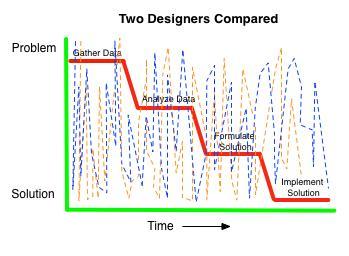
The value of making this non-linearity explicit is to improve the innovation process. When innovation is forced to follow a set linear pattern, it may constrain
or sabotage the creative process. Likewise, frustration may arise if one person is addressing the problem dimension and the other is thinking of solutions, but they do not understand that their thinking may be complementary. Instead of getting frustrated that the other person or persons are not addressing the ‘right’ dimension of the process at the ‘right’ time, they can see that actually the diversity of the thinking is complementary, and by making the process explicit, each person’s idiosyncratic strengths and preferences become a resource for a team, rather than a weakness.

Diagram 7: Conklin’s non-linear problem solving applied to FAM
FAM incorporates the inherent non-linearity of design work into the innovation process. It accepts that a team will need to work across the spectrum of problem to solution dimensions for some time, in order to build think and refinements iteratively, to get to something that makes sense for a new order of emergent complexity in partnership and collaboration.
8 CRC Applications
CRCs and living labs share have many things in common; they bring together business, government and university researchers to develop innovative products and services based on a research theme. Living labs have the added emphasis on the end-user as an active participant, which isn’t always the case for CRCs, but well established in action research practice. The Living Lab approach is gaining interest and traction in Australia and within the CRC program in particular as it brings this extra end-user focus to the innovation program. CRCs and living labs have similar structures and considerations in terms of providing management structures, technical infrastructure, publicity, and managing intellectual property arrangements between participants.
CRC have to re-bid for government funding after 5-7 years, often as part of this rebid process the core strategic theme is refined based on changing government interests and the legacy of the bidding organization. During the last round of CRC bids our strategic foresight unit which conducted futures research within the Smart Service CRC used the “Futures Action Model (FAM)” framework as a mechanism for the parties to develop and refine CRC themes and concepts. Unfortunately the fiscally conservative Abbott government stopped the funding for CRC’s this year, so we were unable to say that the framework actually resulted in a new CRC. Further to this, the use of the FAM framework had the effect of exposing previously hidden differences and assumptions (both practical and conceptual) between various participants and board members. While this may seem a negative outcome we believe that it is better to recognize these differences early, rather than waste funding on an entity without a clear shared strategic intention where the parties may find it difficult to work collaboratively in the future. Innovations FormIT is promoted by ENOLL as one of the core project methodologies. FormIT already promotes the use of Futures techniques as an innovation tool in the concept design cycles. FAM provides a framework that integrates this futures work alongside the later design cycles.
A core issues for many innovation approaches is to avoid developing a service or product that exists elsewhere. Substantial investments can be made only to find an identical product has been developed somewhere else. Using scanning techniques to review global context and responses for the problem identifies possible solutions that already exist. More positively we can view adapting solutions from another place, re-localising them as a type of innovation. Finding other interested parties who have similar problems early may also turn potential competitors into collaborators. Increasingly we live in ‘ecosystems’ of innovations, thus we may find that someone somewhere has solved an important aspect of a problem, but that this innovation is still incomplete and can be partnered with to increase its effect. This is the dynamics in the mobile app market - which only exists by virtue of its ecosystemic dynamics.
Innovations should serve both the immediate and the emerging context. Emerging issues, scanning and core components of much foresight / futures work is often divorced from innovation processes. FAM provides an easy mechanism to build in foresight, to draw a line form the emerging future to the actual products, services and other innovations (social or technical) that should be developed today, helping make sure innovations remain relevant into the future.
FAM has an embedded organizational or stakeholder perspective which naturally aligns to eco-systemic thinking or service dominant thinking approaches to service innovations. This closely aligns with the FormIT principles of keeping the use, business and technologies perspectives in focus. Developing the inner levels of FAM based on the futures context helps identify stakeholders and collaborators in the service eco-system.
9Conclusion
The importance of having a core strategic intention for Living Labs has been documented in several studies. The Futures Action Model provides a mechanism to consolidate the core strategic intention of a Living Lab whether in the set-up stage or as a framework from which to review the strategy of an existing living Lab. FAM provides a link between emerging futures and current actions. It is also a useful innovation process which fits alongside the FormIT methodology and other similar lifecycles. We believe it is a useful addition to the Living Lab tool kit.
10References
Conklin, J. (2006). Dialogue Mapping. Chichester, West Sussex: John Wiley and Sons. City SDK, (2014) City Service Development Kit, http://www.citysdk.eu/europeannetwork-of-living-labs/, Viewed May 2014 Curry, A., Hodgson, A. (2008). Seeing in Multiple Horizons: Connecting Futures to Strategy. Journal of Futures Studies, 13(1). Garcia-Guzman, J., del Carpio, A., de Amescua, A., Velasco, M. A process reference model for managing living labs for ICT innovation: A proposal based on ISO/IEC15501, Computer Standards & Interfaces, 36. Ramos, J. (2013). Forging the Synergy between Anticipation and Innovation: The Futures Action Model. Journal of Futures Studies, 18(1). Veeckamn, C., Shuurman,D., Lemin,S., Westerland, (2013)M. Linking Living Labs Characteristics and their Outcomes. Technology Innovation Management Review, Wadsworth, Y. (2010). Building in Research and Evaluation: Human inquiry for living systems. Crows Nest NSW: Allen & Unwin.

